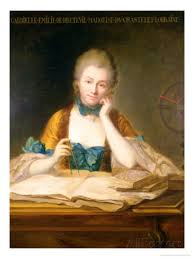Reseña
Émilie du Châtelet was a French lady mathematician, physicist and philosopher who translated Newton's Principia into French. She made significant contributions to the dissemination of the philosophies of Newton and Leibniz in France with his book Les institutions de la physique. One of his most important contributions to science is his explanation of the concepts of energy and the conservation of energy. She introduced Newtonian natural philosophy to the European continent, as well as the vitalist philosophy of Leibniz and Conway in France.
She was also an essayist and letter writer.
We also highlight her work as a grammarian, highly recognized in France during the 18th century, as well as her role as a salonnière.
Justificaciones
- [[en]]Introducer of Isaac Newton's work in France, and for this reason, she is regarded as one of the founders of modern physics.
- [[en]]She introduced Newtonian natural philosophy to the European continent, as well as the vitalist philosophy of Leibniz and Conway in France.
- [[en]]The treatment of force and matter by Châtelet represents a precursor to the concept of energy, which had not yet been formulated by Newton.
Biografía
Émilie du Châtelet received the same education as her two brothers. By the age of ten, she had read Cicero, knew Latin and Greek, as well as Italian and German. She studied mathematics and metaphysics, subjects typically reserved for men. She loved mathematics and continued to study it throughout her life. She followed the communications from the Academy of Sciences, reading Newton, Leibniz, Musschenbroek, and Euler. During her time in Paris, she led an active social life. In 1733, she moved to the Château de Cirey, where she established a large library and a laboratory where all kinds of experiments were conducted, turning it into the French centre of Newtonian science.
18th-century chemistry was filled with controversies regarding the nature of "fire," understood as all manifestations of heat. There was debate over whether it was an elemental principle of bodies or merely a necessary instrument for chemical reactions. Émilie du Châtelet's Dissertation sur la nature et la propagation du feu was published by the Academy of Sciences, an unprecedented honour for a woman. In it, she suggested that the different colours of light appear due to different heating powers and anticipated the existence of what is now known as infrared radiation. In other words, she observed that lights of different colours do not heat the same and clarified that fire is not a material substance.
Around 1745, she began translating Newton’s Philosophiæ Naturalis Principia Mathematica into French. Her translation included extensive commentary to make the work more understandable. The translation was published in 1759, after her death, with a laudatory preface by Voltaire. Mme. du Châtelet’s work made Newton's masterpiece accessible to a wider audience.
She was a respected intellectual who also delved into literature and essay writing. Her book Discourse on Happiness argued that love is the most intense source of pleasure, with the drawback of being dependent on the beloved person, but "the love of study is the most necessary passion for our happiness; it is a reliable remedy against adversity, an inexhaustible source of pleasure." On the other hand, her extensive correspondence makes her a notable epistolographer.
She was part of the culture of scientific salons. Émilie du Châtelet is also recognized as a grammarian. She was highly regarded in 18th-century France and even published Grammaire raisonnée, though only three chapters have survived.
Obras
Dissertation sur la nature et la propagation du feu (1739)
Institutions de Physique (1740)
Discours sur la bonheur (1779)
Principes Mathématiques de la Philosophie Naturelle, par Feue Madame la Marquise du Chastellet (1756)
Correspondence
Grammaire raisonnée
Enfoque Didáctico
In Physics and Chemistry, in the Energy Block, when studying heat and energy, with colours, light, and infrared radiation. When mentioning Newton, as her translator.
In Philosophy and Ethics, with her "Discourse on Happiness".
In Language and Literature, with her written works, her correspondence, and the "Discourse on Happiness". Also in her role as a grammarian and translator.
In History, when studying the Scientific Revolution, the Enlightenment, and the culture of scientific salons.
In Latin, with her French translation of Newton’s manuscript in Latin. Latin as the language of science.
In French, as a writer and a significant figure in French culture and science.
Documentos
